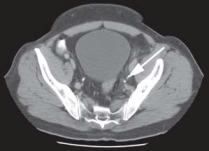Abdominal/Pelvic CT Scans
|
Abdominal/Pelvic CT Scans
CT scanning has drastically changed the evaluation of abdominal disorders and has decreased dramatically the number of unnecessary laparotomies, both traumatic and nontraumatic. It has allowed us to open the “black box” which hides many catastrophic processes, guiding or changing management. While a complete discussion of use of abdominal trauma CT is beyond the scope of this chapter, selected emergency conditions will be presented.
Overview
Patient Preparation
- Patients undergoing abdominal CT for either traumatic or nontraumatic conditions should ideally have oral contrast prep with adequate bowel transit time to allow for visualization of the bowel. The oral contrast is not necessary for investigation of renal colic or abdominal aneurysm, and is optional for traumatic conditions if time does not permit.
- Intravenous contrast is usually given for abdominal CT, but is not necessary for the majority of renal stone CTs, unless more detail of the ureteral anatomy is needed.
Intravenous contrast should be avoided in the setting of renal insufficiency for fear of renal contrast damage or in the presence of the oral hypoglycemic metformin for fear of lactic acidosis.

Figure: Distal left ureter stone (white arrow).
Renal Colic
Since the advent of helical CT, it has quickly replaced intravenous pyelography (IVP) as the initial investigation of suspected renal colic. It can be performed quickly, without the need for patient preparation, or laboratory investigations such as BUN/ creatinine and costs less than IVP.
Acute Appendicitis
Appendicitis is an excellent example of how imaging has changed the practice of medicine. While it has been acceptable to have negative laparotomy rates of up to 30%, this number has come down substantially in those institutions utilizing CT scanning in the investigation of right lower abdominal pain. While initial studies
were performed on selected populations, adding selection bias, high sensitivities and specificities have seemed to hold up in the general population. Like its use in renal colic, it may also reveal alternate diagnoses, thereby obviating exploratory laparotomy/laparoscopy.
Appendiceal CT scanning is performed using helical technique with thin slices through the region of the appendix after the patient has received adequate oral contrast. Rectal contrast is often used to ensure filling of the cecum. Intravenous contrast is commonly used but may be omitted if contraindicated.
Abdominal Aneurysm
Small Bowel Obstruction
- The majority of small bowel obstructions can be diagnosed on plain radiographs and occur in the setting of clear risk factors such as previous surgery or incarcerated hernia.
- When small bowel obstruction is suspected and is either not clear on abdominal radiographs or occurs without a discernable etiology, CT scanning can provide the necessary details.
- CT scanning with bowel contrast preparation is about 90% sensitive and specific for bowel obstruction and may reveal uncommon etiologies such as internal incarcerated hernias, intussusception, or volvulus.
Undifferentiated Elderly Abdominal Pain
|